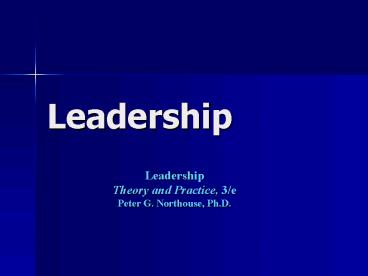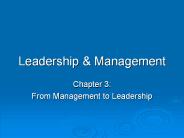Leadership - PowerPoint PPT Presentation
1 / 38
Title:
Leadership
Description:
is a process whereby an individual influences a group of ... Social perceptiveness - Social performance. The accumulation of. information & the mental ... – PowerPoint PPT presentation
Number of Views:58
Avg rating:3.0/5.0
Title: Leadership
1
Leadership
Leadership Theory and Practice, 3/e Peter G.
Northouse, Ph.D.
2
Chapter 1Introduction
3
Leadership Defined
- Leadership
- is a process whereby an individual influences a
group of individuals to achieve a common goal.
4
Components Central to the Phenomenon of
Leadership
Leadership
- Is a process
- Involves influence
- Occurs within a group context
- Involves goal attainment
Leaders
- Are not above followers
- Are not better than followers
- Rather, an interactive relationship with
followers
5
LEADERSHIPDESCRIBED
- Trait vs. Process Leadership
- Assigned vs. Emergent Leadership
- Leadership Power
- Leadership Coercion
- Leadership Management
6
Trait vs. Process Leadership
Trait definition of leadership
- Certain individuals have special innate or inborn
characteristics or qualities that differentiate
them from nonleaders. - Resides in select people
- Restricted to those with inborn talent
7
Trait vs. Process Leadership
The process definition of Leadership
- Leadership is a property or set of properties
possessed in varying degrees by different people
(Jago, 1982). - Observed in leadership behaviors
- Can be learned
8
Assigned vs. Emergent Leadership
Assigned
Emergent
- Leadership based on occupying a position within
an organization - Team leaders
- Plant managers
- Department heads
- Directors
- An individual perceived by others as the most
influential member of a group or organization
regardless of the individuals title - Emerges over time through communication
- Personality
9
Leadership Power
Bases of Social Power French Raven (1959) See
Rusaw p. 38
Power
- Power is the capacity or potential to influence
- Two kinds of power
- Position
- Personal
- Reward
- Coercive
- Legitimate
- Referent
- Expert
Power is a relational concern for both leaders
and followers.
10
Leadership Coercion
Coercion Involves
Examples of Coercive Leaders
- The use of force to effect change
- Influencing others to do something via
manipulation of rewards and penalties in the work
environment - Use of threats, punishments, negative rewards
- Adolf Hitler
- Jim Jones
- David Koresh
Power restraint used to force followers
to engage in extreme behavior
11
Leadership Management Kotter (1990)
Leadership Activities
Management Activities
Produces change and movement
Produces order and consistency
- Planning / Budgeting
- Organizing / Staffing
- Controlling / Problem
- Solving
- Establishing direction
- Aligning people
- Motivating / Inspiring
Major activities of management and leadership are
played out differently BUT both are
essential for an organization to prosper.
12
Leadership ManagementZaleznik (1977)
Managers Unidirectional Authority
Leaders Multidirectional Influence
13
Chapter 2Trait Approach
14
Great Person Theories
Trait Approach one of the first
systematic attempts to study leadership
- Great Man Theories (early 1900s)
- Focused on identifying intrinsic qualities and
characteristics possessed by great social,
political, military leaders
15
Discuss historical shifts in Trait research - Now
16
Leadership Traits
17
Major Leadership Traits
- Intelligence - Intellectual ability including
verbal, perceptual, and reasoning capabilities - Self-Confidence - Ability to be certain about
ones competencies and skills - Determination - The desire to get the job done
(i.e., initiative, persistence, dominance, drive)
- Integrity - The quality of honesty and
trustworthiness - Sociability - Leaders inclination to seek out
pleasant social relationships
18
How Does the Trait Approach Work?
- Focus of Trait Approach
- Strengths
- Criticisms
- Application
19
Focus of Trait Approach
Personality Assessments
Leader
- Focuses exclusively on leader
- What traits leaders exhibit
- Who has these traits
- Organizations use personality assessments to
find Right people - Assumption - will increase organizational
effectiveness - Specify characteristics/traits for specific
positions - Personality assessment measures for fit
20
Strengths
- Highlights leadership component in the leadership
process - Deeper level understanding of how
leader/personality related to leadership process - Provides benchmarks for what to look for in a
leader
- Intuitively appealing
- Perception that leaders are different in that
they possess special traits - People need to view leaders as gifted
- Credibility due to a century of research support
21
Criticisms
- Fails to delimit a definitive list of leadership
traits - Endless lists have emerged
- Doesnt take into account situational effects
- Leaders in one situation may not be leaders in
another situation
- List of most important leadership traits is
highly subjective - Much subjective experience observations serve
as basis for identified leadership traits - Research fails to look at traits in relationship
to leadership outcomes - Not useful for training development
22
Application
- Provides direction as to which traits are good to
have if one aspires to a leadership position - Through various tests and questionnaires,
individuals can determine whether they have the
select leadership traits and can pinpoint their
strengths and weaknesses - Can be used by managers to assess where they
stand within their organization and what is
needed to strengthen their position
- Leadership Traits
- Intelligence
- Self-Confidence
- Determination
- Integrity
- Sociability
23
Chapter 3Skills Approach
24
Skills Approach Description
Definition
Perspective
- Leadership skills - The ability to use ones
knowledge and competencies to accomplish a set of
goals and objectives
- Leader-centered perspective
- Emphasis on skills and abilities that can be
acquired and developed
25
Three-Skill Approach
- Technical Skill
- Human Skill
- Conceptual Skill
26
Basic Administrative SkillsKatz (1995)
Level of Skill Needed
(ideas) Conceptual Skills
Human Skills (people)
Technical Skills (things)
Manager
Director
VP
Exec VP
CEO
27
Technical Skill
- Technical skill - is having knowledge about and
being proficient in a specific type of work or
activity. - Specialized competencies
- Analytical ability
- Capability to use appropriate tools and
techniques - Technical skills involve hands-on ability with a
product or process - Most important at lower levels of management
28
Human Skill
- Human skill - is having knowledge about and being
able to work with people. - Awareness of ones own perspective and others
perspectives at the same time - People skills allow a leader to assist group
members in working cooperatively to achieve
common goals - Creates an atmosphere of trust where members feel
they can become involved and impact decisions in
the organization - Important at all levels of the organization
29
Conceptual Skill
- Conceptual skill - the ability to do the mental
work of shaping the meaning of organizational
policy or issues (what the company stands for and
where its going) - Works easily with abstraction and hypothetical
notions - Central to creating and articulating a vision and
strategic plan for an organization - Most important at top management levels
30
Skills Model of Learning
Leadership Outcomes
Individual Attributes
Competencies
Career Experience
Environmental Influences
31
Individual Attributes
Individual Attributes
General Cognitive Ability
Crystallized Cognitive Ability
Motivation
Personality
- Persons intelligence
- - Perceptual processing
- - Information processing
- - General reasoning
- - Creative divergent
- thinking
- - Memory
- Intellectual ability
- learned or acquired
- over time
- Three aspects of
- motivation
- - Willingness
- - Dominance
- - Social good
- Any characteristic
- that helps people
- cope with complex
- organizational
- situations is
- probably related to
- leader performance
32
Competency Skills
Competencies
Problem Solving
Social Judgment
Knowledge
- Creative ability to solve
- novel, ill-defined
- organizational problems
- Capacity to understand
- people and social systems
- - Perspective taking
- - Social perceptiveness
- - Social performance
- The accumulation of
- information the mental
- structures to organize the
- information
33
Leadership Outcomes
Leadership Outcomes
Problem Solving
Performance
- Originality quality of
- solutions to problem
- situations
- - Logical
- - Effective
- - Unique
- - Go beyond give information
- Degree to which a leader has
- successfully performed his/her
- assigned duties
34
Career Experiences
Career Experiences
Challenging Assignments
Mentoring
Appropriate Training
Hands-on Experience With Novelty
- Experience gained during career influences
leaders knowledge skills to - solve complex problems
- Leaders learn and develop higher levels of
conceptual capacity if they - progressively confront more complex and
long-term problems as they ascend - the organizational hierarchy
35
Environmental Influences
Environmental Influences
Factors Outside of Leaders Control
- Factors in a leaders situation that lie
outside - of the leaders competencies, characteristics,
and - experiences
- - Outdated technology
- - Subordinates skill inadequacies
36
Strengths
- First approach to conceptualize and create a
structure of the process of leadership around
skills - Describing leadership in terms of skills makes it
available to everyone - Provides an overarching view of leadership that
incorporates a variety of components (i.e.,
problem-solving skills, social judgment skills) - Provides a structure consistent with leadership
education programs
37
Criticisms
- Breadth of the skills approach appears to extend
beyond the boundaries of leadership - Skills model is weak in predictive value
- Skills model is partially trait-driven
38
Application
- The Skills Approach provides a way to delineate
the skills of a leader - It is applicable to leaders at all levels within
the organization - The skills inventory can provide insights into
the individuals leadership competencies - Test scores allow leaders to learn about areas in
which they may wish to seek further training































